Improve Your Art
Ever feel that spark, that deep-down urge to make your art better, maybe even a bit faster? Whether you're picking up a pencil for the first time in ages or you're already creating but hitting a bit of a wall, that desire for real, noticeable progress is something every artist gets.
The good news is that improving your skills doesn't have to be some vague, years-long mystery. This guide is all about giving you practical, no-nonsense approaches that can genuinely accelerate your journey, starting with things you can do right now to see a difference.
Use the jump links below to quickly navigate to any specific section on this page.
Quick-Start: 5 Fast Wins for Rapid Progress
This section provides the top 5 evidence-backed actions that yield the fastest results for artistic improvement. It's your express lane to noticeable progress!
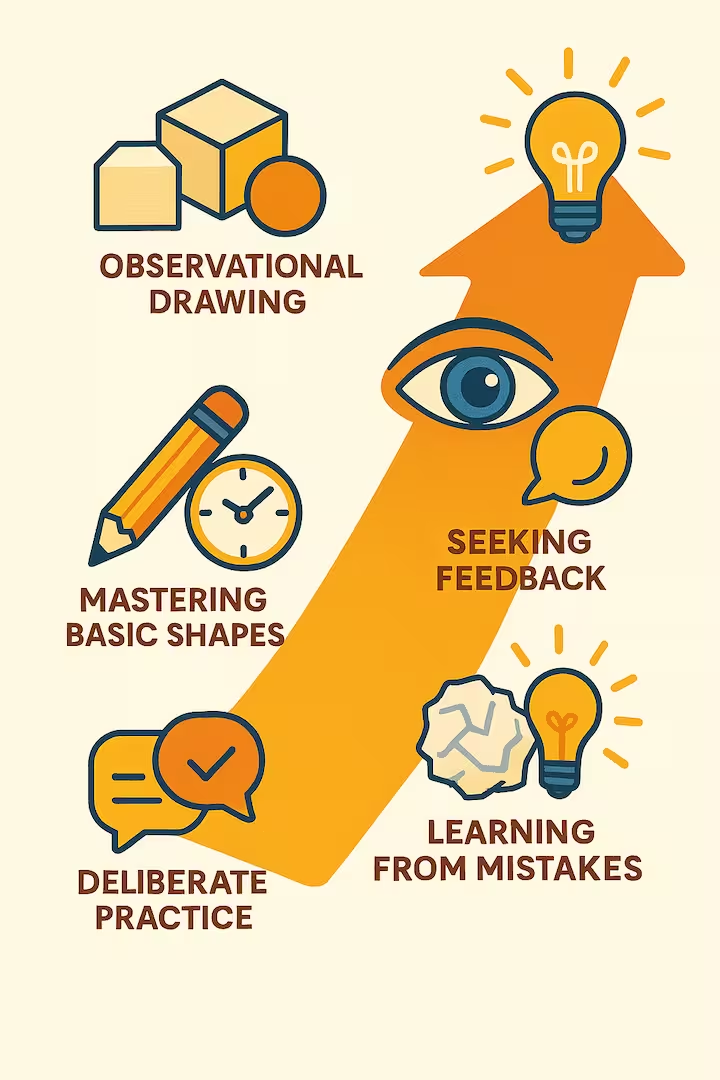
Rapid artistic improvement hinges on consistent, focused effort and a receptive learning attitude. For the fastest results, prioritize these five evidence-backed actions. First, engage in daily deliberate practice, even if for only 15-30 minutes, targeting specific skill weaknesses.[1, 2] Second, master line and basic shapes by practicing straight lines, curves, and simple geometric forms until they become second nature; this control is foundational.[3, 4] Third, commit to consistent observational drawing, working from life or high-quality references to train your eye to see and capture accurately, rather than inventing.[1, 5] Fourth, actively seek and apply specific feedback; solicit constructive criticism and use it to direct your subsequent practice sessions, accelerating error correction.[6, 7] Finally, embrace the "ugly stage" and learn from mistakes, understanding that imperfection is a natural part of the learning process. Analyze what went wrong and try again, fostering a resilient growth mindset.[8, 9] Artists who quickly implement these actions create a powerful positive feedback loop for skill acquisition, building motivation through early successes and sustaining long-term growth.
Fundamental Skills: An Artistic Toolkit
These are the essential building blocks for confident and expressive creation. For Skipping this stage often leads to persistent weaknesses, so a dedicated focus here is paradoxically the most direct "shortcut" to advanced skills. You can find a more in-depth look at these foundational elements on the dedicated Art Fundamentals page.

These skills are not learned in isolation; they are deeply interconnected. For example, achieving accurate proportion depends on keen observation of shapes and the spaces around them. Perspective is constructed using lines and forms. Shading, or the application of value, is what gives these forms a three-dimensional appearance, and these forms are placed according to the rules of perspective and proportion. Color choices, too, are influenced by value and play a significant role in enhancing composition. Recognizing how these elements support and inform one another can make practice more holistic and effective.
Line
The line is the genesis of all drawing. The ability to create confident, controlled, and varied lines is paramount.

Drills:
- Practice connecting two points with straight lines, horizontally, vertically, and diagonally. Vary the length of these lines and the pressure applied to the drawing tool to create lines of different weights (light, medium, dark).[4]
- Extend this practice to curved lines and S-curves, focusing on smooth, controlled movements.[4]
- Engage in continuous line drawing, where the drawing tool is not lifted from the paper for the duration of the sketch. This exercise enhances observational skills and promotes a fluid, connected way of seeing and drawing.[3, 11]
Why it matters: These exercises build crucial muscle memory and improve hand-eye coordination. This leads to more intentional, precise, and expressive marks, forming the very foundation of a drawing's character.[4, 12]
Shape & Form
This involves understanding how to perceive and represent basic two-dimensional shapes (like circles, squares, and triangles) and, critically, how these shapes combine and extend into space to create the illusion of three-dimensional forms (such as spheres, cubes, cones, and cylinders).[1, 3, 4, 10]
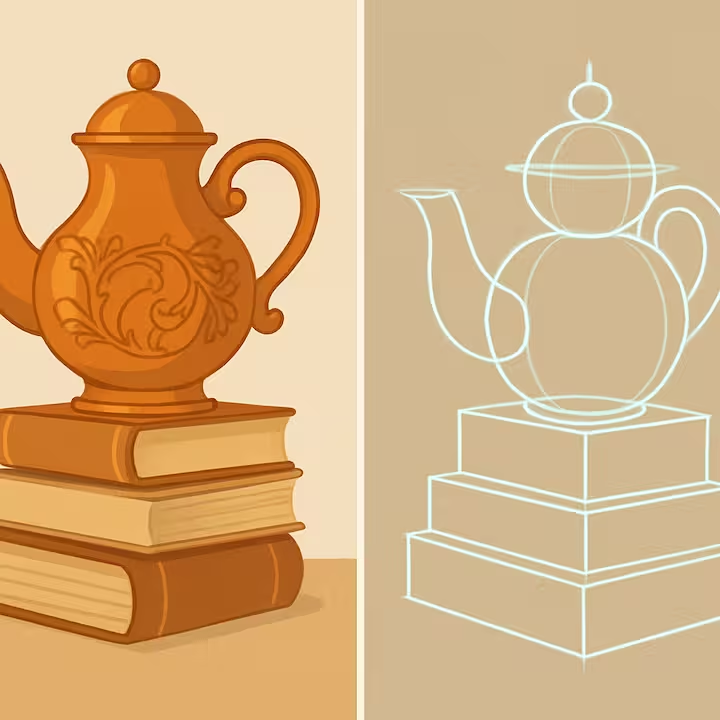
Drills:
- Deconstruct complex objects in the environment or in references into their simplest underlying geometric components. Start with simple objects and gradually move to more intricate ones.[1, 4]
- Practice drawing basic 3D forms from various angles and imagine how light would interact with them.[3, 4]
- Shade these basic forms to give them volume and a sense of solidity, paying attention to how light creates highlights and shadows.[3, 4]
Why it matters: This practice trains the artist to see beyond surface details to the fundamental structure of objects. This structural understanding is essential for accurate representation, construction, and eventually, drawing from imagination.[1, 10] Making drawings appear three-dimensional is a core goal of form drawing.[4]
Gesture
Gesture drawing is about capturing the movement, energy, dynamism, and essential character of a subject, particularly living subjects like humans and animals.[4, 13, 14, 15] It's less about detail and more about the overall flow and "story" or attitude of a pose.
Drills:
- Engage in quick sketching sessions, typically lasting from 30 seconds to 2 minutes per pose. Use live models if possible, or utilize photographs and online resources like Line of Action or Sketchdaily.[3, 4, 14]
- Focus on capturing the line of action, an imaginary line that runs through the main direction of the pose, as well as rhythm and flow.[13, 15] Details and precise accuracy are secondary in these exercises.
Why it matters: Gesture drawing significantly improves observational speed and the ability to understand and convey body language. It injects life and energy into drawings and serves as an excellent warm-up exercise before more sustained work.[14, 15]
Proportion
Proportion deals with the accurate relative sizes of different parts of an object, or of different objects within a composition.[3, 10, 13]
Drills:
- Practice "sighting" by holding a pencil or other measuring tool at arm's length to compare the relative sizes of elements in a subject.[3]
- Employ the grid method for accurately copying images, which helps in understanding spatial relationships.[3]
- Master the "lay-in" process: begin by lightly sketching the largest, most general shapes of the subject. Then, check angles and relationships between key points using techniques like triangulation and plumblines. Make adjustments based on these checks before adding smaller shapes and details.[4]
- For figure drawing, learn basic human proportions, often using the head as a unit of measurement.[10, 13]
Why it matters: Correct proportions are fundamental to creating realistic and believable drawings.[3] Avoid slow measuring at the start of gesture drawing; capture activity first, correct proportions later.[13]
Perspective
Perspective is the art of creating a convincing illusion of depth and three-dimensional space on a two-dimensional surface.[3, 4, 10] It involves understanding vanishing points, the horizon line, and how objects diminish in size with distance.
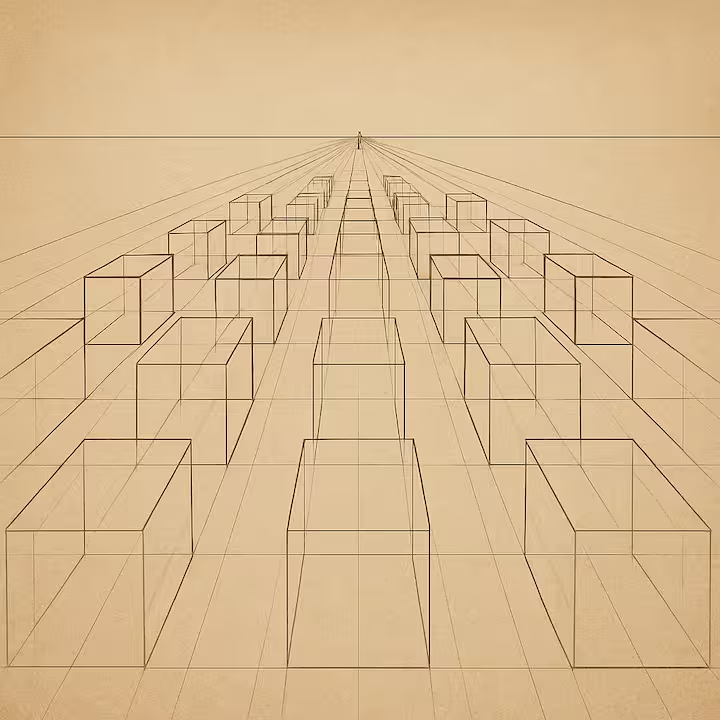
Drills:
- Practice drawing simple geometric forms (cubes, boxes, cylinders) in one-point, two-point, and three-point perspective.[3, 4]
- Sketch real-world scenes (room interiors, cityscapes), actively identifying horizon lines and vanishing points.[3]
- Observe and draw how distant objects appear with less contrast, reduced color saturation, and fewer details (atmospheric perspective).[10]
Why it matters: Perspective makes drawings feel immersive and spatially accurate.[3, 10] Repeated practice with simple shapes builds a strong understanding.[3]
Value (Shading & Light)
Value refers to the range of lightness to darkness. Understanding how light and shadow define form and create depth is critical.[3, 4, 10] Key concepts include highlight, halftone, core shadow, reflected light, and cast shadow.[4]
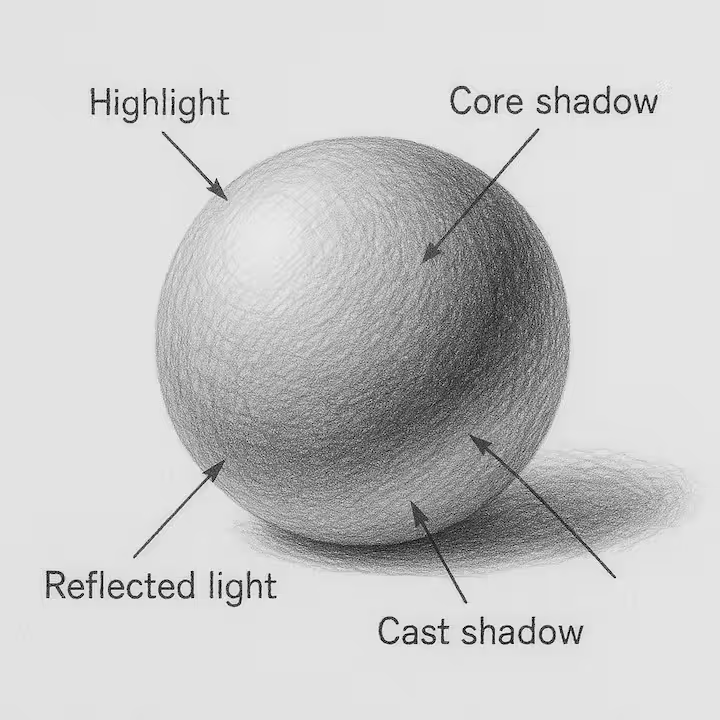
Drills:
- Create value scales to practice smooth transitions between light and dark.[3]
- Shade basic 3D forms, indicating a single light source and rendering all components of light and shadow.[3, 4]
- Conduct value studies from life or photos. Squinting helps simplify subjects into distinct shapes of light and dark.[3, 4]
- Practice rendering different textures using only value variations.[3]
Why it matters: Shading gives drawings realism, volume, and three-dimensionality.[3, 10] Simplifying to 2-value or 3-value studies is excellent practice.[4]
Color
Understanding color involves color theory: hue (pure color), saturation (intensity), and value (lightness/darkness).[3, 10] It also includes color relationships (primary, secondary, tertiary; complementary; analogous) and harmony.
Drills:
- Create color wheels and charts showing tints (color + white), shades (color + black), and tones (color + grey).[3]
- Practice compositions using specific color schemes (monochromatic, analogous, complementary).[3]
- Conduct color studies from life or photos, matching observed colors and noting how light affects them.
- Experiment with how colors interact and evoke moods.[3, 10]
Why it matters: Color adds emotion, realism, depth, and visual interest. Crucial for painters and digital artists.[10]
Composition
Composition is the thoughtful arrangement of visual elements (lines, shapes, forms, values, colors, textures, space) to create a unified, engaging whole.[3, 4, 10]
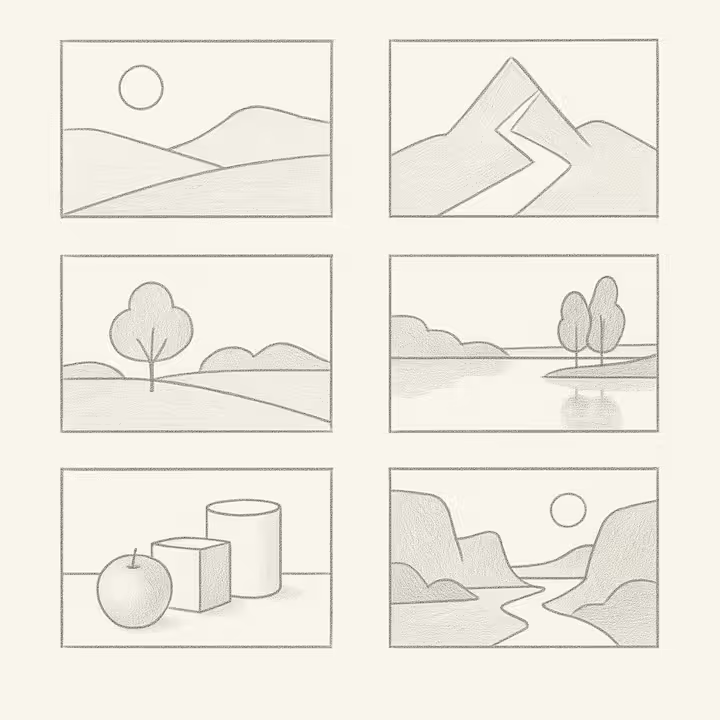
Key Principles:
- Rule of Thirds, balance, contrast, focal point, leading lines, negative space, rule of odds, simplification.[1, 3, 10]
Drills:
- Analyze compositions of master artworks.
- Create multiple quick thumbnail sketches to explore options before committing to a final piece.[16]
- Practice applying specific compositional rules with simple subjects.[10]
- Consciously focus on negative space shapes.[1, 17]
Why it matters: Good composition makes artwork visually compelling, directs attention, and conveys mood.[10]
Fundamental Myths, Busted
Debunking these myths fosters a productive learning environment:
- "You need talent to be good at drawing." Truth: Drawing is a skill developed through practice.[8]
- "It's too late to learn to draw." Truth: Age is not a barrier.[8]
- "You need to be able to draw from imagination." Truth: Imagination is built on extensive observation and reference use.[8]
- "Good artists never make mistakes." Truth: Mistakes are integral to learning.[8]
- "You can't learn without expensive materials." Truth: Basic tools are sufficient.[8]
- "You need formal art training." Truth: Many are self-taught or learn online.[8]
Why debunking these matters: These misconceptions create mental blocks. Understanding they are false empowers learners.[8]
Drill Quick-Reference
| Skill | Specific Drill | Key Benefit |
|---|---|---|
| Line | Connect dots with straight lines (varied length/pressure); Continuous line drawing | Improves line control, hand-eye coordination, flow |
| Shape/Form | Break complex objects into simple geometric shapes; Draw basic 3D forms from different angles & shade them | Trains structural seeing, understanding of volume |
| Gesture | Quick sketches (30s-2min) from life/photos (e.g., Line of Action); Focus on line of action, flow, rhythm | Improves observational speed, captures energy, injects life into drawings |
| Proportion | Sighting with pencil; Grid method for copying; Lay-in process (big shapes first, check, adjust) | Develops eye for relative size, accuracy in representation |
| Perspective | Draw cubes/cylinders in 1, 2, 3-point perspective; Sketch interiors/cityscapes using vanishing points | Creates illusion of depth, makes drawings convincing and immersive |
| Value | Create value scales; Shade basic 3D forms with clear light source; Greyscale studies from life/photos (squint) | Brings realism and 3D to drawings, defines form |
| Color | Create color wheels/mixing charts; Practice color schemes; Color studies from life/photos | Adds emotion, realism, visual interest; understanding of color relationships |
| Composition | Thumbnail sketches for options; Analyze masterworks; Practice rule of thirds; Focus on negative space drawing | Guides viewer's eye, creates impact and aesthetic appeal |
Deliberate Practice: Train Smarter
Deliberate practice is about focused, structured sessions designed to push you just beyond your comfort zone, systematically addressing weaknesses. It's about the quality and intention behind each effort, not just mindless repetition.
One excellent way to challenge yourself and develop a wide range of artistic skills is by exploring narrative art, which requires strong composition, character development, and storytelling
The psychological elements are vital: commitment to self-improvement, willingness to operate at the edge of abilities, and resilience to seek and learn from feedback.[18, 20] This proactive, analytical engagement with one's own work is what distinguishes deliberate practice from simple repetition.
SMART Goals for Artists
The SMART framework (Specific, Measurable, Achievable, Relevant, Time-bound) transforms vague intentions into actionable plans.[7, 22]
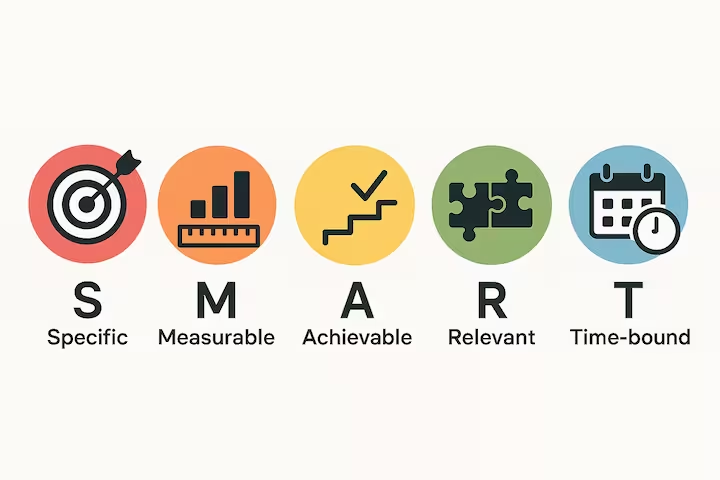
- S - Specific: Clear goals, e.g., "improve accuracy of finger proportions in a relaxed hand pose."
- M - Measurable: Trackable progress, e.g., "draw five relaxed hands rated 'accurate' against photo reference."
- A - Achievable: Realistic given current skill and time.
- R - Relevant: Aligns with broader artistic aspirations.
- T - Time-bound: Deadline for urgency, e.g., "within two weeks."
Example: "My objective is to accurately render the planes of the human head using the Loomis method (Specific). I will measure this by completing 10 head studies from 3D model references, aiming for at least 80% accuracy in plane identification as reviewed against anatomical charts (Measurable & Achievable). This is crucial for my portraiture development (Relevant) and I aim to complete these studies within the next 4 weeks (Time-bound)."[22, 23]
Why it matters: SMART goals provide clarity, focus, and a tangible way to track progress, essential for structuring deliberate practice.[7, 22]
Spaced Repetition in Art
Reviewing information or skills at increasing intervals combats the "forgetting curve," strengthening neural pathways for long-term retention.[24, 25, 26]
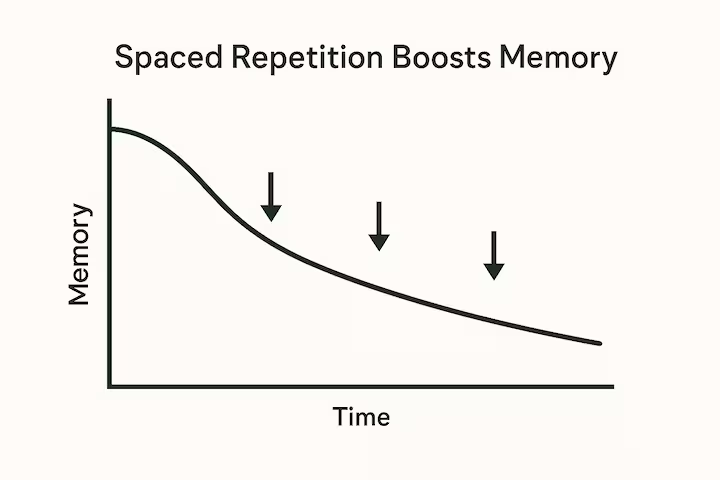
Application to Art:
- Factual Knowledge (Anatomy, Theory): Use tools like Anki for flashcards on anatomy (e.g., bone landmarks), perspective rules, color theory (e.g., complementary colors), or composition rules.[28, 29, 30, 31, 32, 33, 34]
- Procedural Skills (Techniques & Drills): Schedule periodic re-engagement with specific techniques or exercises (e.g., gesture drawing sessions every few days, then weekly). This reinforces the execution of the skill itself, not just memorization.[24, 25, 35]
Why it matters: Optimizes learning time, leading to robust long-term retention of theoretical knowledge and practical skills.[25, 26]
Effective Feedback Loops
A continuous cycle of practice, feedback, adjustment, and further practice is critical.[6, 7, 19, 36, 37]
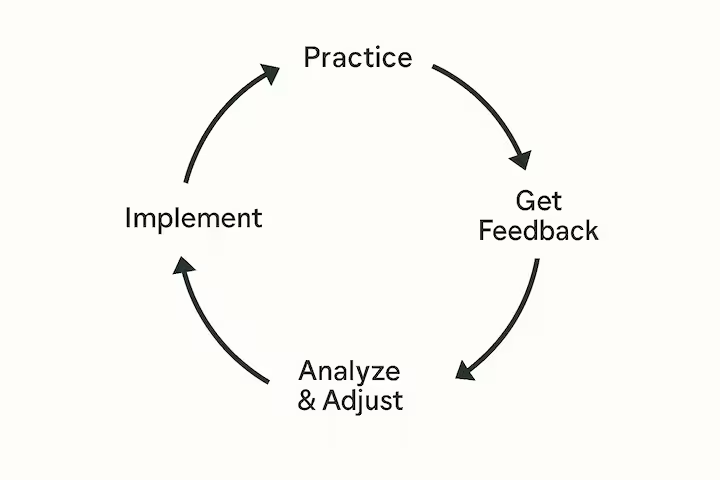
Types of Feedback:
- Self-Critique: Objectively evaluate your work against references, using checklists based on fundamentals.
- Peer Review: Share work with fellow artists for constructive criticism.[6, 38]
- Mentor Feedback: Guidance from an experienced artist or teacher for deeper insights.[18, 38]
Why it matters: Feedback identifies blind spots and weaknesses. Early and regular feedback corrects errors before they become ingrained, accelerating learning.[6, 7, 18] This dynamic interplay propels artists toward innovation.[36]
Mileage Milestones
"Art mileage" is the sheer volume of practice accumulated. It builds muscle memory, hand-eye coordination, and intuitive understanding.[39, 40]
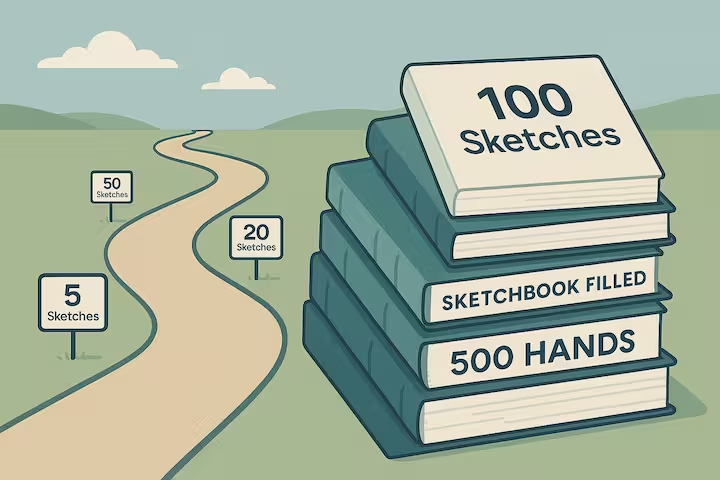
Setting Milestones:
Make mileage tangible with concrete, quantifiable milestones to track progress and provide accomplishment.
- Examples: "Complete 100 gesture drawings this week," "Fill one sketchbook page daily for 30 days," "Complete Ahmed Aldoori's '100 Heads Challenge' in 10 weeks," "Draw 500 hands in two months," "Complete Drawabox Lesson 1," "Create one master study from memory monthly for six months."[16, 41, 42, 43, 44, 45]
Why it matters: Consistent mileage builds intuitive skill and confidence. Milestones provide a roadmap, break down tasks, and offer opportunities to celebrate progress, fueling motivation.[40, 43, 46]
Practice vs. Finished Work: Finding the 50% Balance
Rapid improvement requires a balance between:
- Focused Skill-Building Exercises: Drills isolating specific skills (e.g., drawing only ellipses, cross-hatching).
- Creating Finished Pieces: Integrating multiple skills to create complete artworks, applying learning in context.
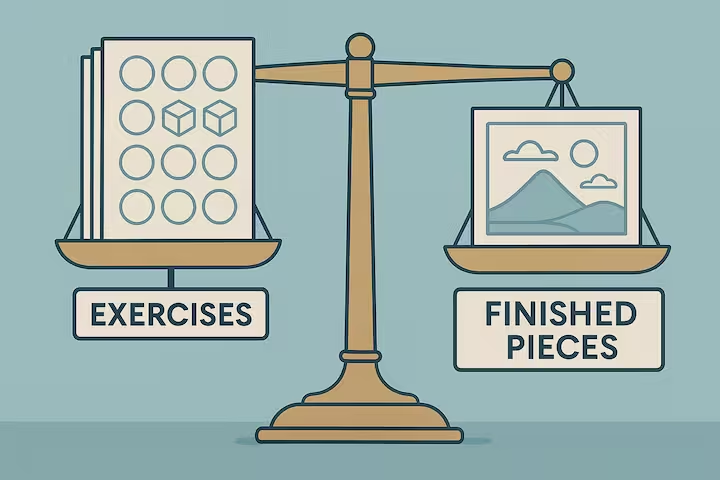
Finding the Optimal Balance: The "50% rule" from Drawabox suggests dedicating at least half of art time to drawing for its own sake (play, personal projects) and at most half to structured study.[47] This maintains joy and prevents practice from becoming purely mechanical.
Why it matters: Ensures both targeted skill development and the ability to apply skills holistically, sustaining motivation.

Deliberate Practice Framework for Artists
| Component | Art-Specific Application | Why It Accelerates Learning |
|---|---|---|
| Goal Setting | Use SMART goals for a specific skill (e.g., "Draw 10 accurate hand proportions in 2 weeks using Loomis method") | Provides clear direction, focus, and measurable progress, making practice efficient. |
| Focused Exercise | Timed gesture drills (e.g., 30-second poses); Drawing only one subject/feature repeatedly (e.g., eyes, cubes in perspective) | Builds muscle memory and skill in a specific, weak area by isolating it. Pushes beyond comfort zone. |
| Feedback Loop | Self-critique against reference; Peer critique (e.g., via Discord, ArtStation); Mentor review of practice work | Identifies blind spots and errors quickly, allowing for targeted correction and refinement. |
| Spaced Repetition | Anki flashcards for anatomy/color theory terms; Scheduling periodic review/practice of specific drills or concepts | Combats forgetting curve, ensures long-term retention of knowledge and procedural skills. |
| Mileage/Volume | Daily sketching; "100 Heads Challenge"; Filling sketchbooks; Tracking number of studies completed (e.g., 500 hands) | Builds intuitive skill, confidence, and automaticity through sheer volume of practice. |
| Reflection/Refinement | Analyzing what worked/didn't in a practice session; Adjusting the next session's focus based on feedback/self-assessment | Ensures that each practice session is more effective than the last; turns practice into active learning. |
Sketchbook & Daily Habits for Consistency
A consistent sketchbook habit is a cornerstone of rapid artistic development. It's a private lab for experimentation, practice, and idea generation without pressure. The freedom to make "ugly art" here is liberating and essential for growth.
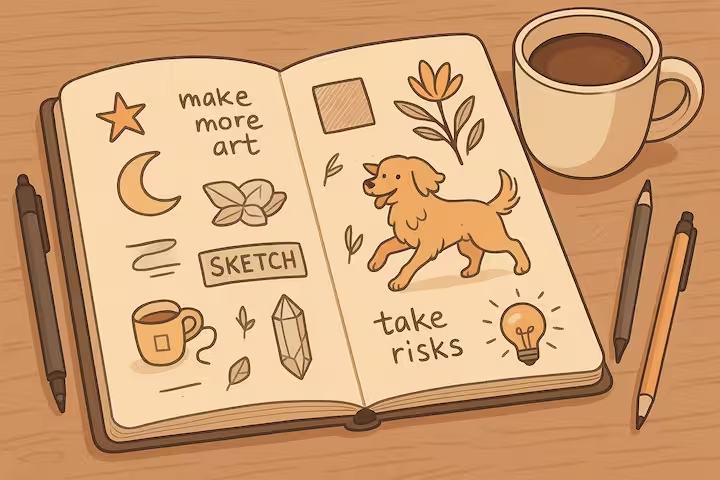
Frequency and Time-Boxing
Consistency trumps sporadic intensity. Aim for daily practice, even 10-15 minutes.[1, 11, 17, 49, 50] Consider flexible 5-30 minutes daily, with "light days" (simple doodles) to maintain the habit.[50] Time-boxing (setting a timer for 5, 10, or 20 minutes) overcomes resistance and maintains focus.[11, 49, 51]
Why it matters: Regular, scheduled practice is more effective for skill acquisition and habit formation. Time-boxing makes practice manageable.[21, 52]
Effective Sketchbook Habits
- Strive to fill the entire page (unless negative space is intentional).[53]
- Work through pages sequentially, avoiding skipping, for a chronological record.[53]
- Use both sides of the page (select media to prevent bleed-through).[53]
- Draw lightly initially for erasing, or creatively incorporate mistakes.[12, 53]
- Date entries to track development.[12]
Why it matters: Ensures the sketchbook is used efficiently as a tool for learning and reflection.[53]
Warm-ups
Preparatory exercises (5-15 minutes) before complex work, like drawing basic shapes, lines, blind contours, or quick gestures.[11, 12, 14, 17, 18]
Why it matters: Improves hand-eye coordination, sharpens focus, enhances line quality, and mentally prepares for the session.[17, 18]
Timed Drills
Short, focused exercises with a strict time limit (e.g., 30s-2min gesture drawings, 5-min compositional sketches).[11, 14]
Why it matters: Cultivates efficiency, decisiveness, ability to capture essentials quickly, and overcomes perfectionism.[11, 14]
Art Time Drawing Routine for Busy Schedules
- Habit Stacking: Pair drawing with an existing daily routine (e.g., 15 mins after coffee).[49, 54]
- Start Simple & Small: Begin with tiny, non-intimidating goals (e.g., simple shapes for 5 mins).[49, 55]
- Carry a Sketchbook: Utilize micro-moments of free time.[52]
- Time Reallocation: Reduce less productive activities for art practice.[52]
- Treat Art Time as Non-Negotiable: Schedule it like an important appointment.[52]
Why it matters: Makes consistent practice feasible with time constraints, building momentum through manageable steps.
Reference & Observation: Learning to See Accurately
A fundamental shift is learning to draw what is actually seen, not preconceived symbols. Train your eye to deconstruct subjects into lines, shapes, values, negative space, and form. Active, analytical seeing transforms looking into understanding.
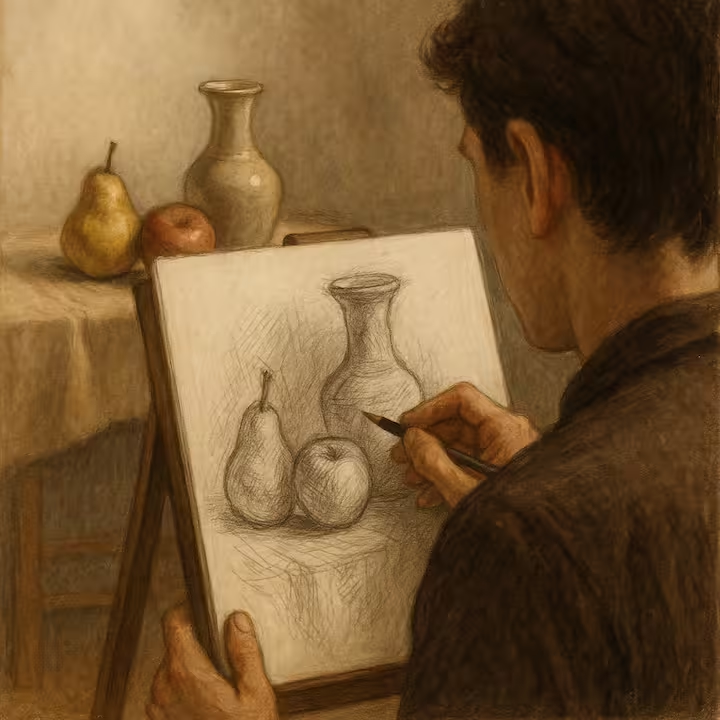
Building and Using Effective Image Libraries
Collect high-quality reference photos aligned with interests and goals (anatomy, animals, environments).[56, 57] Free resources: Pixabay, Unsplash, Pexels, Morguefile, Paint My Photo, The Artist Reference Image Library.[56, 57] Organize systematically.
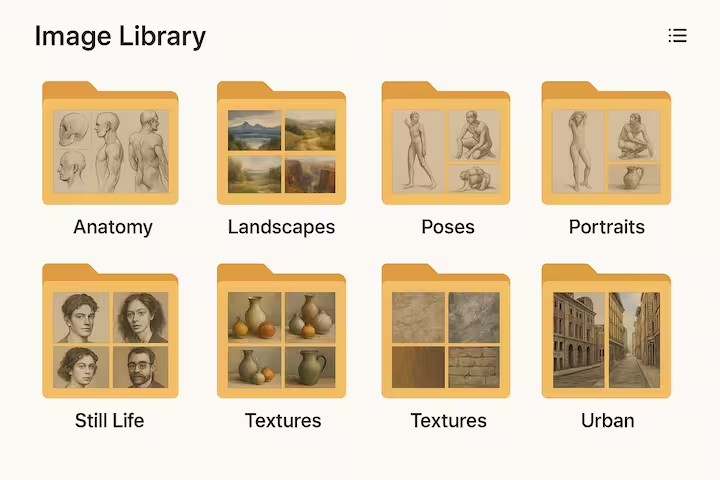
Why it matters: Provides endless material for study, practice, and inspiration, supporting consistent practice.
The Power of Life Drawing
Drawing from real, 3D subjects (people, still life, environments) is potent for skill acceleration.[5, 58]
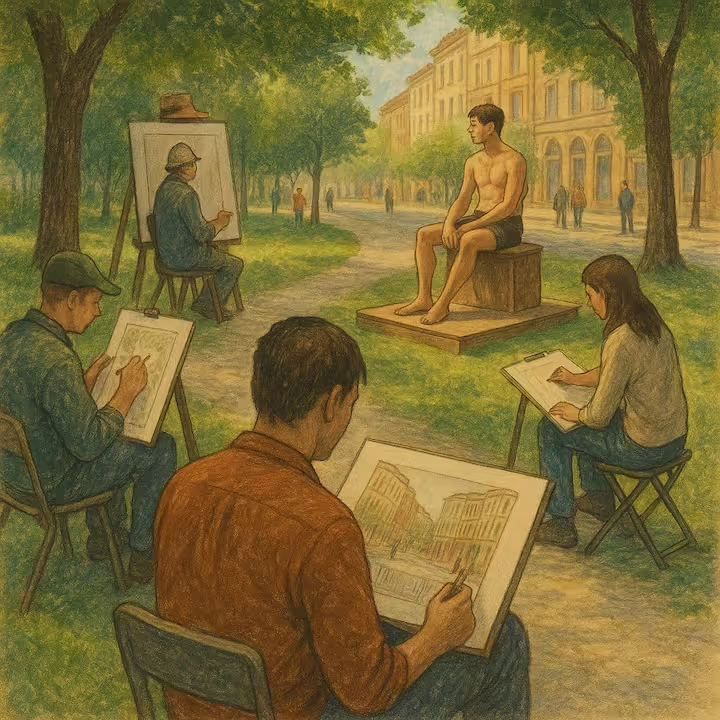
Benefits:
- Richer understanding of anatomy, form, volume, and light compared to photos.[5, 58]
- Sharpens observational acuity, ability to simplify, and problem-solving skills.[5]
- Captures dynamism, weight, and 3D that photos flatten.
"Going out drawing" / Sketchwalks: Drawing on location hones skills in depicting dynamic environments, improves speed, and builds confidence.[59, 60, 61, 62]
Why it matters: Unparalleled for developing understanding of form in space and translating the 3D world to 2D rapidly.
Effective Photo Studies
Valuable when life drawing isn't an option, if approached with clear learning objectives.[63, 64]
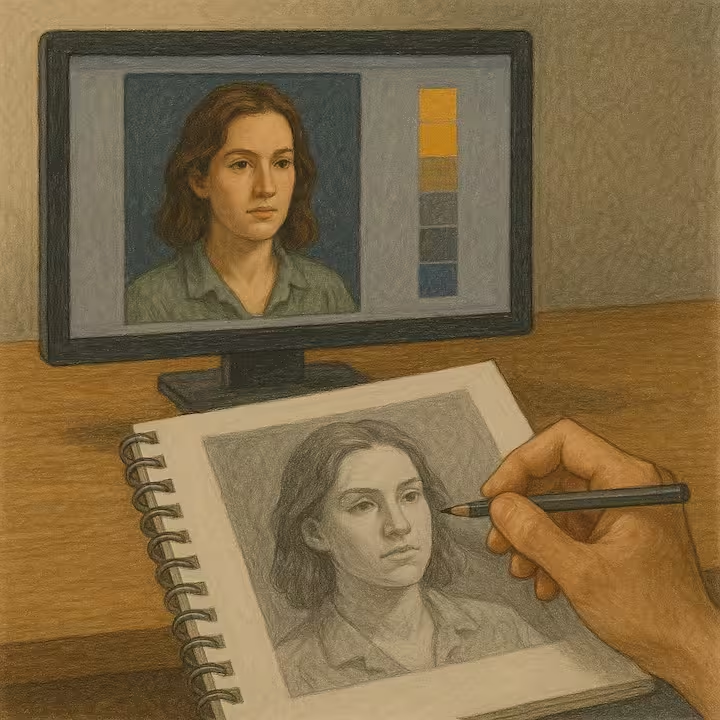
Technique:
- Greyscale studies: Convert photo to B&W to isolate values and understand form.[64]
- Manually select colors/values: Use color picker, not eyedropper, to train perception.[64]
- Line art underdrawing or block in large shapes: For complex subjects, establish structure first.[64]
- Stay zoomed out: Focus on overall forms before details.[64]
- Flip canvas horizontally: Spot errors in proportion/symmetry.[64]
- Time limit: Encourage focus on essentials.
Why it matters: Bridges theoretical knowledge and practical application, allowing focused learning on elements like value or color.
Anatomy Resources for Artists
Solid, simplified anatomy understanding is indispensable for believable figures/animals.[4, 10] A "visual library" is built through active, repeated observational studies.[1]
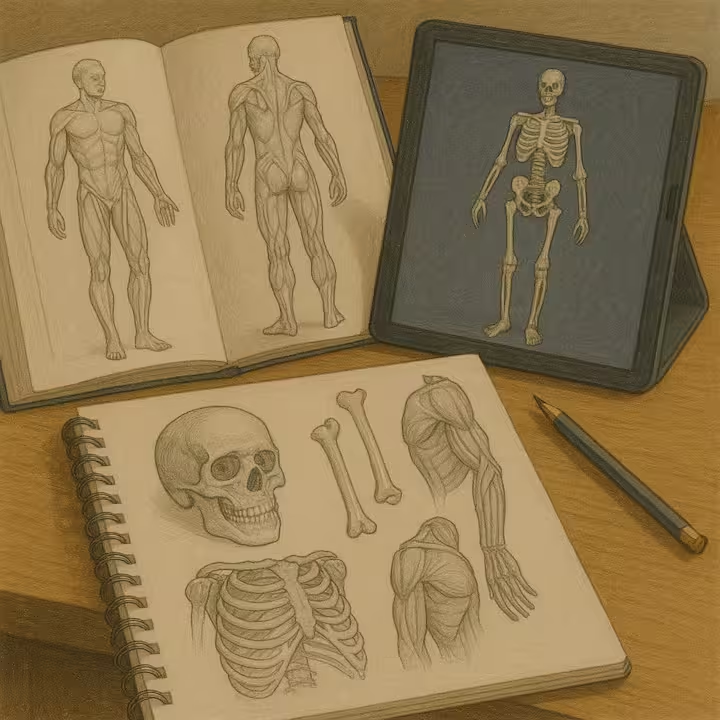
Recommended Books (check for current editions for 2025):
- Andrew Loomis: *Figure Drawing for All It's Worth*, *Drawing the Head and Hands*.[65]
- George B. Bridgman: *Bridgman's Complete Guide to Drawing From Life*.[5, 65, 66]
- Burne Hogarth: *Dynamic Anatomy*.[65]
- Michael Hampton: *Figure Drawing: Design and Invention*.[13, 66]
- Others: Fritz Schider, Valerie L. Winslow, Eliot Goldfinger, Gottfried Bammes.[65, 66]
Websites/Apps (check current reviews for 2025):
- Proko (YouTube & Proko.com).[5]
- Line-of-Action.com, Sketchdaily.net.[4]
- 3D Anatomy Apps: VOKA 3D Anatomy, Human Anatomy Atlas 2025, TeachMeAnatomy, Anatomy Learning - 3D Anatomy.[67, 68]
Why it matters: Reliable resources provide foundational knowledge. Combine book study, apps, and regular practice.
Specific Problem Area: "How to draw backs (human anatomy)"
Simplify complex back musculature.[69, 70, 71]
- Basic Forms: Torso as tilted cubes/boxes for ribcage and pelvis.[69]
- Key Bony Landmarks: Spine (S-curve), rib cage mass, scapulae, pelvis.[69, 71]
- Simplified Major Muscle Groups: Trapezius (diamond/arrowhead), Latissimus Dorsi (wing-like), Erector Spinae (parallel tubes), Deltoids, Obliques.[69, 70]
- Step-by-Step Construction [69]: Line of action -> Ribcage/pelvis forms -> Major muscle shapes -> Lighten underdrawing -> Clean contours -> Line weights/shading.
Why it matters: Breaking down complex anatomy makes it less intimidating and easier to learn quickly.
Specific Problem Area: "Drawing hands easier"
Simplify the hand's complex structure.[72, 73, 74]
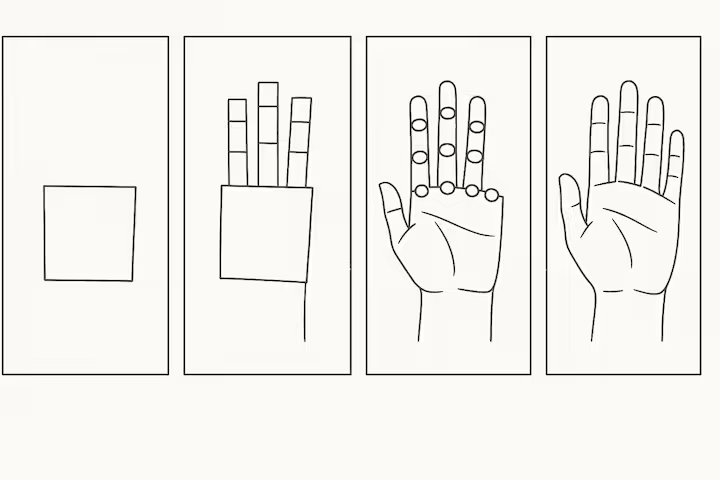
- Chunking: Break hand into smaller parts (palm, thumb, finger segments) and practice separately.[72]
- Basic Shapes: Palm as square/trapezoid/box; fingers as connected cylinders/boxes.[73, 74]
- Structure First: Understand basic bone structure; mark knuckles clearly.[74]
- Use Abundant References: Photos, 3D models, your own non-drawing hand.[74]
- Step-by-Step Approach [74]: Basic bone structure/shapes -> Mark knuckles -> Draw fingers as 3D forms -> Refine contours -> Add details -> Finalize with lines/shading.
Why it matters: Systematic simplification makes hands more approachable, leading to faster improvement.
Digital vs. Traditional: Tools for Accelerated Learning
Digital tools offer flexibility and forgiveness, speeding up experimentation and iteration crucial for rapid improvement. They facilitate deliberate practice: targeted repetition, immediate feedback, and rapid iteration.
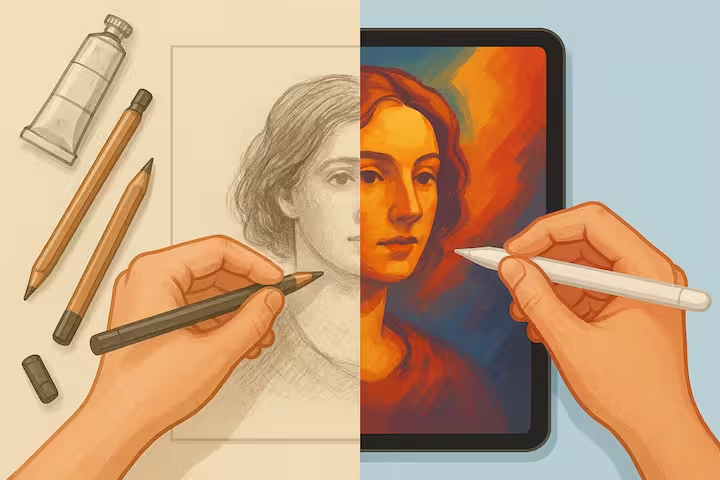
When Software Accelerates Learning:
- Layers: Work on elements independently, experiment non-destructively.[76]
- Undo/Redo: Reduces fear of experimentation, saves time and materials.[75, 76, 77]
- Transform Tools (Scale, Rotate, Warp, Liquify): Quick adjustments for proportion/placement.[75, 76]
- Zoom Capabilities: Work on details and assess overall impact easily.[76]
- Brushes & Textures: Vast libraries and customization speed up rendering.[76]
- Color Tools: Flexible color selection, experimentation, and adjustment.
- 3D Reference Models: (e.g., in Clip Studio Paint) Accurate references for anatomy, perspective.[76]
- Practice Without Material Cost: Encourages more experimentation and mileage.[76]
-
Specialized Features in Apps:
- Procreate: QuickShape, StreamLine, Drawing Guides, Animation Assist.[78, 79]
- Adobe Fresco: Live Brushes, vector brushes, "Paint Inside" feature.[80, 81, 82]
Why it matters: Digital tools lower the "cost" of mistakes, providing flexibility for iteration and fearless experimentation.
Potential Pitfalls of Digital Tools:
The "safety net" can lead to less disciplined approach if not managed consciously.[75, 76]
- Over-reliance on undo/transform might hinder foundational accuracy if not balanced with precise practice.
- Vast tool options can be overwhelming, leading to focus on effects over core skills.
Why it matters: Use digital tools as aids, not crutches. Balance with traditional constraints for optimal improvement.
iPad Apps That Speed Up Learning to Draw:
- Procreate: Intuitive, powerful features (QuickShape, StreamLine, Drawing Guides).[77, 78, 79, 83]
- Adobe Fresco: Versatile with Live Brushes, vector tools, Creative Cloud integration.[80, 81, 82]
- ShadowDraw: Guided learning by following professional artists' steps (subscription-based).[84]
Why it matters: These apps simplify complex tasks, make fundamentals accessible, and encourage experimentation.
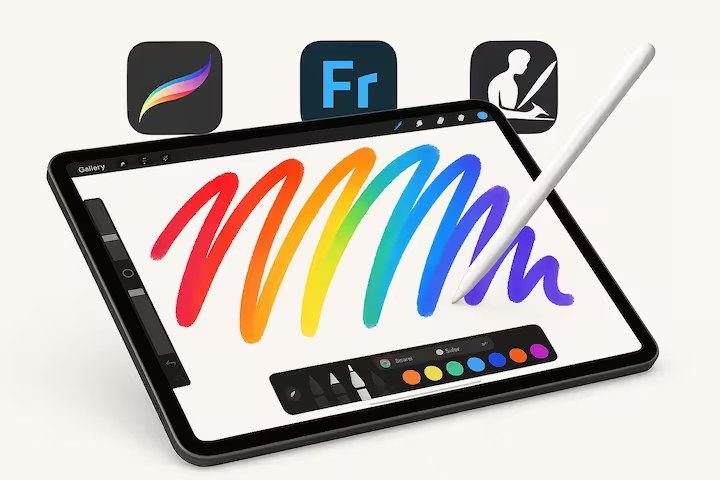
Traditional Tools Still Matter:
- Foster direct, tactile connection to materials, deepening understanding.
- Absence of "undo" forces careful planning and deliberate mark-making.
Why it matters: A balanced approach is often most effective. Discipline from traditional practice enhances digital art.
Feedback & Critique: Your Growth Accelerators
Engaging with constructive criticism is integral for growth. It helps identify blind spots and accelerates error correction. The ability to give and receive critique is a skill that improves your own analytical abilities.
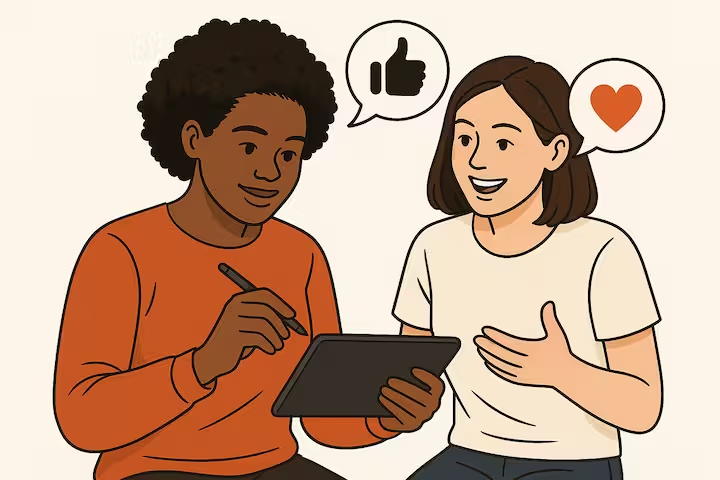
Why Feedback is Crucial for Rapid Growth:
- Identifies Blind Spots: Fresh eyes pinpoint overlooked flaws.[6, 7, 18, 85]
- Offers New Perspectives: Challenges assumptions, suggests alternatives.[6, 36]
- Accelerates Error Correction: Highlights mistakes early, preventing ingrained bad habits.[18]
- Drives Artistic Evolution: Pushes artists to refine vision and innovate.[6]
Why it matters: Without feedback, artists can stagnate, slowing potential for rapid improvement.
Finding Mentors:
An experienced artist/educator providing personalized, ongoing guidance.[18, 38]
- Sources: Art teachers, experienced friends, online communities, formal programs.[38, 86]
- Approach: Be respectful of time/expertise. Consider value exchange or compensation.[38, 85, 87]
Why it matters: A good mentor offers high-quality, individualized feedback, a significant shortcut in learning.
Leveraging Online Communities & Peer Reviews:
Platforms for sharing work and receiving feedback from a global community.
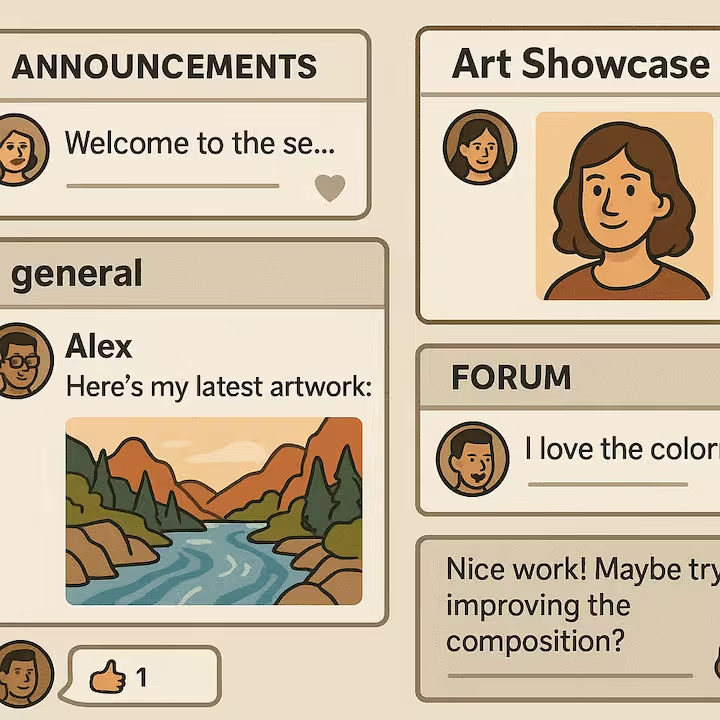
-
Platforms:
- ArtStation: Professional showcase, good for networking.[38]
- PolyCount: CG/game dev community, expert users, constructive feedback.[38]
- Discord Servers: "Art Club," "Nees Art Corner," "CG Core," "Illustration Station," "Midjourney" (for AI art prompt feedback).[88, 89] Find active, constructive servers.
- Other Social Media: Facebook groups, Instagram, Reddit (r/learnart, r/ArtCrit) - feedback quality varies.
Why it matters: Accessible avenues for diverse perspectives, peer support, and motivation.
How to Ask for and Receive Constructive Feedback:
The approach impacts quality and utility.[85, 87]
- Be Specific: Ask targeted questions (e.g., "Are torso/limb proportions correct?").[85, 87]
- Choose Right Time/Person/Venue: Work developed enough but not final. Experienced peers/mentors ideal.[85]
- Give Permission for Honesty: State constructive criticism is welcome.[85]
- Listen Actively, Avoid Defensiveness: Absorb comments, don't argue.[85, 87]
- Reflect and Apply Selectively: Consider all critiques, apply what resonates with goals.[19, 36]
Why it matters: Transforms feedback from daunting to a powerful growth tool. Curate sources and communicate needs.
A/B Iterations for Artists:
Adapting product design's A/B testing: create multiple versions with slight variations to gain objective insights.[90, 91, 92, 93]
Process:
- Define Goal/Hypothesis (e.g., "Make character more heroic by broadening shoulders").
- Create Variations (A and B with shoulder difference).
- Gather Feedback (e.g., "Which feels more heroic, and why?").
- Analyze Results for patterns.
- Iterate based on insights.
Why it matters: Moves beyond subjective decisions by gathering data on how visual choices impact viewers. Turns choices into testable hypotheses.
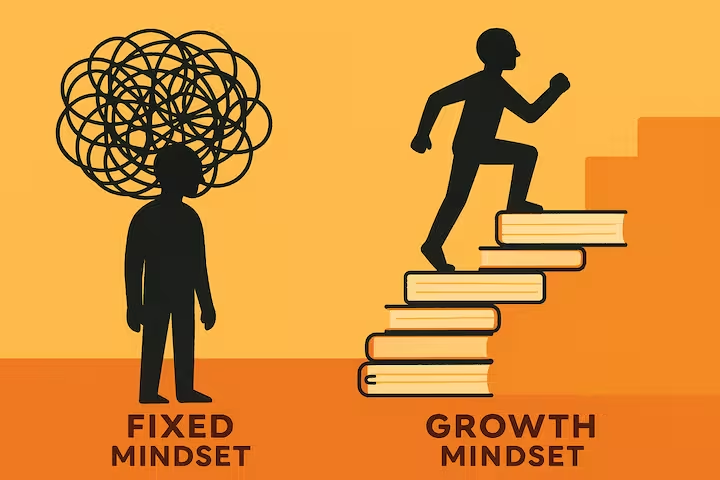
Mindset & Motivation: The Inner Game of Art
Artistic improvement is an internal journey as much as an external one. Mindset and sustained motivation are critical for growth. The perfectionism-burnout cycle is a common trap; a growth mindset is a key antidote.
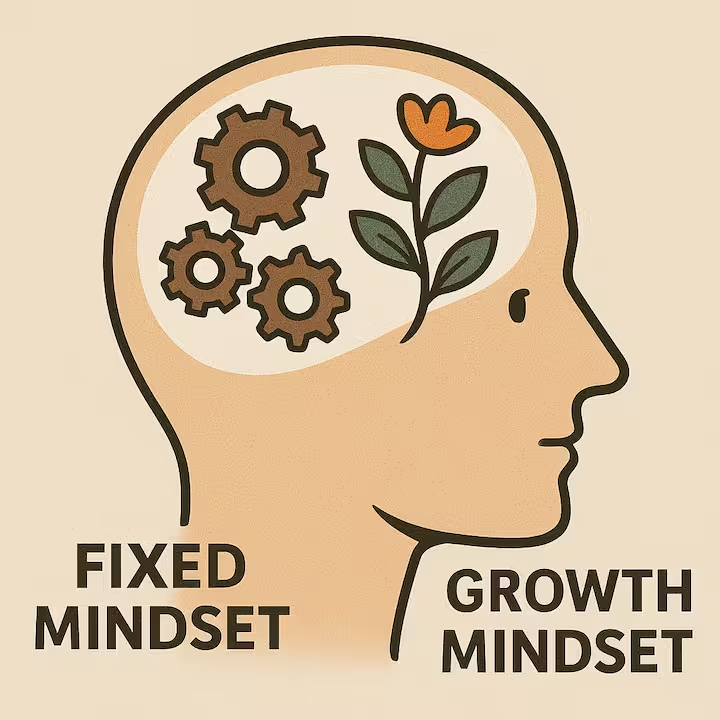
Cultivating a Growth Mindset:
Belief that abilities can be developed through dedication, hard work, and learning (Carol Dweck).[9]
- Embrace Challenges: View as opportunities to learn.[9, 21]
- Learn from Mistakes: See errors as invaluable information.[8, 9, 20]
- Value Effort and Process: Focus on the journey, persistence.[9]
- Seek and Utilize Feedback: Use as a tool for growth.[9]
- Celebrate Progress: Acknowledge small victories.[9, 95]
Why it matters: Psychological foundation for deliberate practice and resilience, essential for rapid improvement.[9]
Avoiding Perfectionism:
Perfectionism hinders progress, leading to procrastination and fear.[48]
Strategies:
- Practice Self-Compassion: Be kind to your artistic process.[48, 95]
- Finish What You Start (Even if Imperfect): Aim for "good-enough" (e.g., 70% quality).[48]
- Keep Creating, Even "Bad" Art: Continuous practice builds skills.[48]
- Embrace Mistakes as Learning Tools.[48]
- Incorporate Playfulness: Timed sessions, "make a mess on purpose."[48, 51]
- Break Down Large Projects into smaller steps.[48]
- Seek Feedback for Progress, Not Perfection.[48]
Why it matters: Overcoming perfectionism liberates artists to experiment, learn from mistakes, and produce more work.
Recovering from Burnout & Sustaining Motivation:
Burnout is exhaustion from prolonged stress.[94] Sustaining motivation ("keep going drawing") needs proactive strategies.
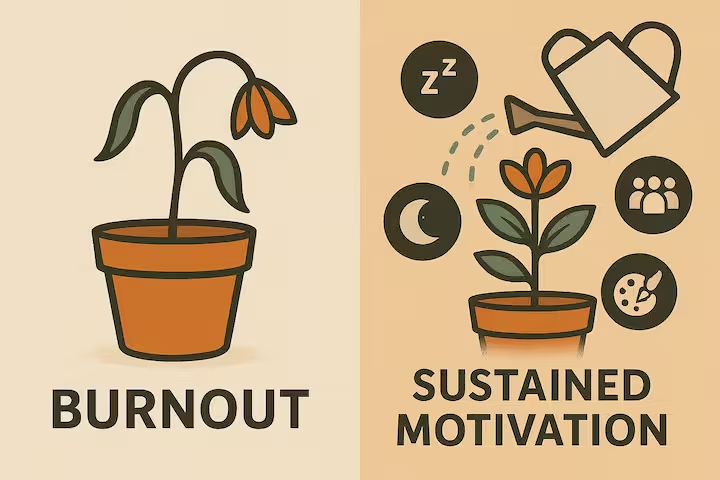
Recovery Techniques for Burnout:
- Rest and Breaks: Regular short breaks, longer breaks between projects.[94]
- Realistic Goal Setting: Avoid overload, break tasks down.[94]
- Prioritize Self-Care: Exercise, meditation, hobbies, social time.[94, 95]
- Community Connection: Support from fellow artists.[94, 95]
- Art for Joy: Create without pressure.[94]
- Set Boundaries: Learn to say "no."[94]
- Reflect on Achievements: Acknowledge accomplishments.[94]
Sustaining Motivation:
- Build Habits, Not Reliance on Motivation: Routines are reliable.[49, 54]
- Find a Deeper Purpose: Connect drawing to passion projects/goals.[54]
- Accountability: Share plans with art buddy/community.[54]
- Lower the Bar on Low-Energy Days: Commit to short sessions/simple tasks.[49, 54]
- Vary Your Practice: New mediums, subjects to refresh inspiration.[54, 95]
- Judicious Use of New Supplies (not primary motivator).[54]
- Create a Positive Environment (music, podcasts).[54]
- Reward Progress.[51, 54]
Why it matters: Managing energy, overcoming low motivation, and recovering from burnout are crucial for consistent practice.
Understanding Why Artists Draw:
Driven by diverse intrinsic (internal) and extrinsic (external) motivations.[98, 99, 100]
- Intrinsic: Self-expression, joy/passion, learning/understanding, personal growth/mastery, flow state.[98]
- Practical/Extrinsic: Defining ideas/planning, recording observations, career aspirations, communication, connection.[99, 54]
Why it matters: Tapping into strong intrinsic motivations fuels sustained effort and resilience.[98]
Navigating Common Roadblocks: Your Map Through Challenges
The path to artistic improvement has its bumps. Recognizing common challenges and having strategies to navigate them is crucial for maintaining momentum. These roadblocks can be diagnostic, signaling underlying issues.

Artistic Plateaus:
Feeling skills have stagnated despite practice.
Strategies:
- Take a Deliberate Break: Refresh perspective.[101, 102]
- Change Environment/Routine: Shake things up.[50, 101]
- Experiment Vigorously: New medium, unfamiliar subject.[101, 102, 103]
- Revisit/Strengthen Fundamentals: Often the root cause.
- Seek Targeted Feedback: Mentor/teacher might spot the issue.[18]
- Copy and Create (Master Studies with a Twist): Recreate then transform.[103]
- Productive Procrastination: Art-related tasks like organizing studio.[103]
Why it matters: Plateaus are normal. Strategies prevent prolonged stagnation.
The Comparison Trap (Especially with Social Media):
Comparing work to others, leading to inadequacy/envy.[104, 105]
Strategies:
- Focus on Your Own Unique Journey/Voice.[104]
- Mindful Social Media Consumption: Limit if triggers negativity.[104, 105]
- Use Others' Work as Inspiration, Not Self-Judgment.[105]
- Cultivate a Supportive, Non-Competitive Community.[104]
- Track Personal Progress: Compare with your past self.[40, 105]
Why it matters: Comparison trap drains motivation. Shifting focus inward promotes genuine growth.
The "Ugly Phase" of an Artwork:
Intermediate stage where work looks messy/unresolved.[106]
Strategies:
- Persist Through It: Normal part of the process.[106]
- Take Strategic Breaks: Return with fresh eyes.[106]
- Experiment and Take Risks: Opportunity to try new approaches.[106]
- Seek Feedback: Trusted peer/mentor might help.[106]
- Practice Self-Compassion: Be patient, it's a stage.[106]
Why it matters: Prevents abandoning potentially successful artworks prematurely.
Fear of the Blank Page / Creative Block:
Intimidation of blank canvas or feeling creatively stuck.[51, 101, 102, 103]
Strategies to Overcome Art Block Fast:
- Idea Generation List: Refer to when uninspired.[51]
- Timed Starts: 5-10 mins to just make marks.[51, 101]
- Small Rewards for starting/completing tasks.[51]
- Use Drawing Exercises/Prompts: Removes decision burden.[47, 51]
- Embrace "Trash Art"/Imperfection: Combats perfectionism.[51]
- Switch Materials/Tasks or Change Scenery.[51, 101, 102, 103]
- Rest and Basic Needs: Fatigue often causes blocks.[51, 101, 102]
- The 50% Rule (Drawabox): Dedicate half of drawing time to "play."[47]
Why it matters: Small, actionable steps build momentum and rediscover creative flow.
Getting Started/Restarted After a Long Break:
Returning can feel daunting due to rusty skills.[12, 55, 107, 108]
Gentle Re-entry Strategies:
- Reflect on Reasons for Stopping to avoid past pitfalls.[55]
- Adopt "Zero Expectations" Mindset: Allow scribbles, just re-engage.[55, 107]
- Ease In Gradually: Focus on process, not outcome.[55]
- Create Sustainable/Completable Plan: Short, achievable time goals.[55]
- Stick with Absolute Basics: Line control, basic shapes.[12, 55]
- Prioritize Enjoyment: Make it fun and positive.[55]
- Confidence-Building Line Exercises: Overlap technique, line pressure, hatching.[12, 108]
Why it matters: Gentle, process-oriented approach rebuilds confidence and habit.
Tackling "Something to Draw Hard" (Difficult Prompts/Subjects):
Systematic approach fosters learning over frustration.[47, 109, 110, 111]
Strategies:
- Decomposition (Break it Down): Complex subject into simpler components/shapes.[72, 109, 110, 111]
- Ample Reference Usage: Multiple high-quality references are critical.[109]
- Study Underlying Structure/Anatomy.[109]
- The "What If" Strategy: For conceptual prompts, thumbnail multiple ideas.[47]
- Embrace Failure as Learning Tool: Expect mistakes, goal is learning.[47]
- Start Small, Build Control: Simpler related exercises first if subject is too daunting.[47]
Why it matters: Transforms difficult subjects into valuable learning opportunities.
Roadblock-Busting Strategies
| Common Roadblock | Key Symptoms | Top 1-2 Quick Strategies |
|---|---|---|
| Artistic Plateau | Skills feel stagnant despite practice; lack of noticeable improvement. | Try a new medium/subject; Revisit and drill specific fundamentals. |
| Comparison Trap | Feeling inadequate/demotivated when viewing others' art, especially online. | Limit social media art consumption; Focus on your own progress by reviewing past work. |
| The "Ugly Phase" | Frustration with how an artwork looks mid-process; wanting to abandon it. | Take a short break for fresh eyes; Remind self it's a normal stage & keep pushing. |
| Fear of Blank Page | Anxiety or inability to start drawing; creative block. | Use a 5-minute timer to just start; Make "trash art" with no expectations. |
| Getting Back into Drawing | Intimidation after a long break; feeling rusty or that skills are lost. | Start with simple scribbles/basic shapes with ZERO expectations; Focus on fun for 10 mins. |
| "Something to Draw Hard" | Feeling overwhelmed by a complex subject/prompt; fear of not doing it justice. | Break the subject into very small, simple shapes/steps; Gather lots of reference. |
Quick Wins vs. Long Games: Balancing Boosts with Mastery
Rapid improvement blends quick visual enhancements with sustained practice for long-term mastery. Understanding this distinction is key for realistic expectations and lasting growth.

| Aspect of Art | Quick Win (Action & Benefit) | Long Game (Action & Benefit) |
|---|---|---|
| Line Quality | Action: Use a good fineliner; Practice "ghosting" lines for 10 mins. Benefit: Immediately cleaner lines. |
Action: Months of dedicated line exercises; Consistent gesture drawing. Benefit: Intuitive, expressive, confident line work. [4, 12] |
| Proportions | Action: Use grid method to copy a photo; Trace landmarks. Benefit: Accurate proportions for one piece. [3] |
Action: Internalize anatomy; Consistent sighting/measurement from life; Constructing forms with proportional systems. Benefit: Accurately judge/depict proportions from observation/imagination. [3, 4] |
| Shading / Value | Action: Copy value patterns from high-contrast photo, simplifying to 3-5 values. Benefit: Single drawing with good light/form. |
Action: In-depth study of light physics; Extensive rendering of basic forms under various lighting; Understanding atmospheric perspective. Benefit: Invent convincing lighting, render form with subtlety from understanding. [3, 4] |
| Color | Action: Use pre-made color palette; Follow color mixing tutorial. Benefit: Harmonious colors in one piece. |
Action: Deep study of color theory; Extensive color mixing exercises; Observational color studies from life. Benefit: Create unique, expressive color schemes intuitively; masterful control. [3, 10] |
| Composition | Action: Apply "Rule of Thirds"; Use viewfinder to crop. Benefit: Quick improvement in balance/interest for one piece. |
Action: Consistent analysis of masterworks; Regular thumbnail sketching; Experimenting with various principles. Benefit: Intuitive understanding of arrangement for impact and message. [10, 16] |
| Motivation | Action: Watch inspiring video; Buy new art supply; Join fun challenge. Benefit: Temporary boost in enthusiasm. [54] |
Action: Cultivate growth mindset; Build consistent habits; Nurture intrinsic joy; Connect with supportive community/mentor. Benefit: Sustained passion, resilience, lifelong engagement. [9, 49, 54] |
| Learning Anatomy | Action: Trace anatomical diagrams; Use 3D model for pose reference. Benefit: Helps accuracy for one drawing/pose. |
Action: Systematic study of skeletal/muscular systems; Regular figure drawing from life/reference focusing on construction; Creating anatomical study sheets. Benefit: Deep understanding to draw convincing figures from observation/imagination. [5, 13, 66] |
Quick fixes are most effective when integrated into a broader, long-term strategy focused on deep understanding and consistent application of fundamental principles. Rapid improvement often results from efficiently mastering these long-game strategies through deliberate practice.
FAQs
Common questions from beginner and intermediate artists seeking rapid improvement.
1. How can I improve my drawing skills quickly?
Practice consistently, even for short periods each day. Focus on simple exercises like gesture drawing, basic shapes, and studying from life. Over time, you’ll see steady improvement.
2. What are some good daily drawing exercises?
Try gesture drawings, contour sketches, quick studies of objects around you, or copying master drawings. Warm-ups like circles and straight lines can also help improve your control.
3. Should I draw from imagination or from reference?
Both are important! Drawing from reference helps you understand how things look and work, while drawing from imagination strengthens your creativity. Try to balance both in your practice.
4. Why do my drawings look stiff?
Stiffness often comes from focusing too much on details early on. Try starting with loose, flowing lines and focus on capturing the overall movement before adding details.
5. How do I get better at shading and adding depth?
Practice drawing basic 3D forms (cubes, spheres, cylinders) and experiment with different lighting. Observe how shadows and highlights work on real objects, and use a range of values in your drawings.
6. What should I do when I feel like I’m not improving?
Plateaus are normal! Try switching up your routine, following a new tutorial, or studying a different subject. Sometimes taking a break or drawing for fun can help you get unstuck.
7. Is it better to use traditional or digital tools for practice?
Both have their benefits! Traditional tools help you develop solid fundamentals, while digital tools offer flexibility and undo options. Use whichever feels most comfortable, or try both.
8. How important is anatomy for figure drawing?
Understanding basic anatomy is very helpful for drawing convincing figures, but you don’t need to memorize every bone or muscle. Start simple and gradually add more knowledge as you go.
9. What’s the best way to find my own art style?
Your style will develop naturally over time as you draw more and explore what you enjoy. Try studying a variety of artists, experimenting with techniques, and letting your preferences guide you.
10. How do I stay motivated to keep drawing?
Set small, achievable goals, join online art communities, or participate in challenges. Remember to draw things you enjoy, and don’t be too hard on yourself, progress takes time!
Annotated Source List
Credible books, studies, YouTube channels, and art blogs for artistic improvement. Full URLs are illustrative and may need verification.
Books:
- Hampton, Michael. Figure Drawing: Design and Invention. Michael Hampton, 2009. [13, 66]
Note: Acclaimed for clear, structural approach to figure drawing, emphasizing form, gesture, anatomy. - Loomis, Andrew. Figure Drawing for All It's Worth. Titan Books, 2011 (reprint). [65]
Note: Classic text on proportion, perspective, form, accessible style. - Loomis, Andrew. Drawing the Head and Hands. Titan Books, 2011 (reprint). [65]
Note: Indispensable classic, detailed construction methods for complex forms. - Bridgman, George B. Bridgman's Complete Guide to Drawing From Life. Sterling Publishing, 2001 (reprint). [5, 65, 66]
Note: Influential, focuses on wedging/interlocking forms; profound insights into dynamic structure. - Schreiter, Felix. Drawing Fundamentals: The Definitive Guide (2024). HowToPracticeDrawing.com. [4]
Note: Comprehensive online guide, systematic breakdown of fundamentals, actionable drills. - Dweck, Carol S. Mindset: The New Psychology of Success. Ballantine Books, 2007. (General Learning)
Note: Influential on growth vs. fixed mindsets; crucial for artists to embrace challenges.[9] - Clear, James. Atomic Habits: An Easy & Proven Way to Build Good Habits & Break Bad Ones. Avery, 2018. (General Learning)
Note: Relevant for building consistent practice routines; habit stacking, small easy habits.[49, 54]
Peer-Reviewed Studies / Learning Science Concepts:
- Ericsson, K. Anders, et al. "The role of deliberate practice in the acquisition of expert performance." Psychological Review, 1993.
Note: Landmark paper on "deliberate practice"; scientific basis for focused, goal-oriented practice.[2, 7, 18, 19, 20] - Ebbinghaus, Hermann. Memory: A Contribution to Experimental Psychology. 1885.
Note: Established "forgetting curve"; basis for spaced repetition for long-term retention.[25, 26, 27]
YouTube Channels:
- Proko (Stan Prokopenko):
youtube.com/user/ProkoTV
Note: Highly respected; anatomy, figure drawing, portraiture, fundamentals.[5] - Love Life Drawing:
youtube.com/channel/UCBoM0qLHzs-I0b2R02z6qvg
Note: Figure drawing, gesture, making learning enjoyable.[10] - moderndayjames (James Douglas):
youtube.com/user/moderndayjames
Note: In-depth tutorials on perspective, anatomy, composition for concept art.[112] - Sinix Design:
youtube.com/user/sinixdesign
Note: Digital painting, form, anatomy quick tips, color.[112] - Ahmed Aldoori:
youtube.com/user/revolutions34
Note: Inspiring content, process videos, "100 Heads Challenge."[41, 112]
Art Blogs & Websites:
- Drawabox.com (Irshad Karim):
drawabox.com
Note: Free, exercise-based course on foundational skills; "50% rule."[47] - Ctrl+Paint (Matt Kohr):
ctrlpaint.com
Note: Free videos on digital painting fundamentals.[114] - Artist Strong (Carrie Secrist):
artiststrong.com
Note: Deliberate practice, goal setting, mindset.[18, 113] - HowToPracticeDrawing.com (Felix Schreiter):
howtopracticedrawing.com
Note: Detailed guides on fundamentals and practice methods.[4] - Castle Arts Blog:
castlearts.com/blogs/castle-arts-blog
Note: Practical tips for beginners, fundamentals.[1] - Fine Art Tutorials:
finearttutorials.com
Note: Debunking drawing myths, foundational concepts.[8] - CG Spectrum Blog:
cgspectrum.com/blog
Note: Core skills for digital art careers.[10]
Work Cited
- How to Get Better at Art: 13 Simple Ways to Improve ... - Castle Arts, https://castlearts.com/blogs/castle-arts-blog/how-to-get-better-at-art
- Deliberate Practice in Art: Learn How to Draw Faster - Tatyana Deniz, https://tatyanadeniz.com/deliberate-practice/
- Mastering the fundamentals of drawing: Understanding proportion ..., https://www.douglashydegallery.com/mastering-the-fundamentals-of-drawing-understanding-proportion-perspective-shading-and-composition/
- Drawing Fundamentals: The Definitive Guide (2024), https://www.howtopracticedrawing.com/blog/drawing-fundamentals-definitive-guide
- what is life drawing and its benefits – Mary Li Art, https://maryliart.com/what-is-life-drawing-and-its-benefits
- Feedback loops: Feedback in Art: The Role of Feedback in the Evolution of Art - FasterCapital, https://www.fastercapital.com/content/Feedback-loops--Feedback-in-Art--The-Role-of-Feedback-in-the-Evolution-of-Art.html
- Deliberate Practice - FasterCapital, https://fastercapital.com/keyword/deliberate-practice.html
- Debunking the Biggest Drawing Myths - Fine Art Tutorials, https://finearttutorials.com/guide/drawing-myths/
- The Importance of a Growth Mindset for Artists: Embrace Challenges ..., https://revart.co/blogs/179_The_Importance_of_a_Growth_Mindset_for_Artists_Embrace_Challenges_and_Foster_Creativity
- Learning the 6 Fundamentals of Art: Essential Skills for Every Artist, https://www.cgspectrum.com/blog/learn-the-fundamentals-of-art
- 10 Quick Drawing Exercises for Daily art Practice, https://www.makingsandmusings.com/post/10-quick-drawing-exercises-for-daily-art-practice
- 6 Easy Exercises to Improve Your Line Quality | Draw Confident ..., https://www.thedesignsketchbook.com/5-exercises-to-improve-your-line-quality-and-drawing-confidence/
- Figure Drawing: Design and Invention by Michael Hampton, https://cursoseorientacoes.com/wp-content/uploads/2014/09/michael-hampton-figure-drawing-design-and-invention-1.pdf
- What are the Benefits of Gesture Drawing? – ScrawlrBox, https://scrawlrbox.uk/blogs/scrawlrblog/gesture-drawing
- Art in Motion: Making Friends with Gesture Drawing, https://www.21-draw.com/what-is-gesture-drawing/
- Daily Sketchbook Challenge: Improve Your Skills in 30 Days - YouTube, https://www.youtube.com/watch?v=zw5SX7KbZTk
- Improve your drawing skills with these easy tips | Our Time, https://ourtime.org.uk/resource/improve-your-drawing-skills/
- How to Get Better at Drawing: Train Your Eyes to See Like an Artist ..., https://www.artiststrong.com/how-to-get-better-at-drawing-train-your-eyes-to-see-like-an-artist/
- Beyond Repetition: The Power of Deliberate Practice - Sheila B ..., https://www.sheilabrobinson.com/beyond-repetition-the-power-of-deliberate-practice/
- The Ultimate Deliberate Practice Guide: How to Be the Best - Farnam Street, https://fs.blog/deliberate-practice-guide/
- The Science of Rapid Skill Acquisition: A Comprehensive Guide, https://www.1hourguide.co.za/the-science-of-rapid-skill-acquisition/
- How to Set SMART Art Goals 2023 santafepaintingworkshops.com, https://santafepaintingworkshops.com/smartgoals/
- 3 Tips for Setting Goals for your Artistic Practice and Art Business - Mimimoo Illustration, https://www.mimimooillustration.com/blog/3-tips-for-setting-goals-for-your-artistic-practice-and-art-business
- How Hobby Skills are Improved by Repetition! - Hobbify, https://hobbify-skills.com/how-repetition-improves-hobby-skills/
- Spaced repetition (article) | Learn to Learn | Khan Academy, https://www.khanacademy.org/science/learn-to-learn/x141050afa14cfed3:learn-to-learn/x141050afa14cfed3:spaced-repetition/a/l2l-spaced-repetition
- Spaced repetition: Science-backed secret to long-term memory - Voovo, https://www.voovostudy.com/study-blog/the-art-of-learning-the-power-of-spaced-repetition
- Spaced repetition and the 2357 method - Exams and Revision ..., https://www.bcu.ac.uk/exams-and-revision/best-ways-to-revise/spaced-repetition
- How to learn anatomy with Anki: Flashcards, review | Kenhub, https://www.kenhub.com/en/library/learning-strategies/how-to-learn-anatomy-with-anki
- Anki flashcards with only the essential bones for artists? - Reddit, https://www.reddit.com/r/Anki/comments/1f80475/anki_flashcards_with_only_the_essential_bones_for/
- Using spaced repetition for learning facts, forming habits, and re-reading quotes, https://andrewtmckenzie.com/spaced_repetition
- How do I Ankify concepts? : r/Anki - Reddit, https://www.reddit.com/r/Anki/comments/s7zbpi/how_do_i_ankify_concepts/
- 100 Colors (Advanced) - AnkiWeb, https://ankiweb.net/shared/info/661303954
- Color Theory Vocabulary Flashcards - Quizlet, https://quizlet.com/14768660/color-theory-vocabulary-flash-cards/
- 8 Rules of Composition in Art Flashcards - Quizlet, https://quizlet.com/359592335/8-rules-of-composition-in-art-flash-cards/
- Improve Your Art With Spaced Repetition - the ultimate step-by-step ..., https://www.youtube.com/watch?v=J_j3BunQ6AQ
- Feedback loops: Feedback in Art: Creative Cycles: The Essence of ..., https://www.fastercapital.com/content/Feedback-loops--Feedback-in-Art--Creative-Cycles--The-Essence-of-Feedback-in-Art.html
- Deliberate Practice Strategies , Part 7: Repetition and Conclusion - Percussive Arts Society, https://pas.org/pas-blog/deliberate-practice-strategies-part-7-repetition-and-conclusion/
- Where should novices look for feedback? - ArtCraft Education, https://artcraft.education/where-look-for-feedback
- What doesn " mileage" mean in the context of drawing? I just watched a video about how to draw anima - italki, https://www.italki.com/en/post/question-501283
- Mileage and why you should keep your old works. by InkyTophat on ..., https://www.deviantart.com/inkytophat/journal/Mileage-and-why-you-should-keep-your-old-works-433992686
- 100 heads challenge - Pinterest, https://www.pinterest.com/mohamedkhamisaldhraifalshamsi/100-heads-challenge/
- Sooo i did 100 heads as a total beginner : r/learnart - Reddit, https://www.reddit.com/r/learnart/comments/w97x0f/sooo_i_did_100_heads_as_a_total_beginner/
- Goal Setting For Artists - Serena Archetti, https://www.serenaarchetti.com/blog/goal-setting-for-artists
- Drawing Milestones - The OT Toolbox, https://www.theottoolbox.com/drawing-milestones/
- Drawing Development in Children: The Stages from 0 to 17 Years - Little Big Artists, https://www.littlebigartists.com/articles/drawing-development-in-children-the-stages-from-0-to-17-years/
- How to Set and Track 5 Essential Milestones for Project Success - Voiset, https://www.voiset.io/blog/how-to-set-milestones-and-track-progress
- Part One: The Basics | Lesson 0: Getting Started ... - Drawabox.com, https://drawabox.com/lesson/0/2/prompts
- Surface Design & Perfectionism: Embracing Mistakes to Grow as an ..., https://sketchdesignrepeat.com/surface-design-and-perfectionism-embracing-mistakes-to-grow-as-an-artist/
- How to Motivate Yourself to Draw Every day – in 5 tips! | Patricia Pedroso, https://www.patriciapedroso.com/how-to-draw-every-day/
- 3 Drawing Routines That Actually Work (Even if You're Busy, Tired ..., https://keshart.in/blog/3-drawing-routines-that-actually-work-even-if-youre-busy-tired-or-kinda-lazy/
- 8 Tips for Conquering "Blank Page" Fear , Marissa Valdez, https://www.marissavaldez.com/blog/8-tips-for-conquering-blank-page-fear
- How to Make Time for Art: 7 Tips for Busy Artists, https://evolveartist.com/blog/making-time-for-making-art/
- TIP #15: 4 Habits for Better Sketchbooks • TeachKidsArt, https://www.teachkidsart.net/tip/tip-15-4-habits-for-better-sketchbooks/
- 7 Tips for Drawing When You Have No Motivation – Binge Drawing, https://bingedrawing.com/inspiration/draw-with-no-motivation/
- How to Get Back into Drawing After a Long Break & Succeed, https://drawism.com/how-to-get-back-into-drawing-after-a-long-break/
- Free reference photo websites for artists and creatives - Learn My Craft, https://learnmycraft.com/in-the-studio/free-reference-photos/
- 17 Royalty-FREE Image Resources for Artists - Stephanie Weaver Fine Art Artist, https://stephanieweaverartist.com/blogs/art-instruction/17-royalty-free-image-resources-for-artists
- The Role of Drawing in Artistic Development - The Artsology Blog, https://artsology.com/blog/2025/04/drawing-in-artistic-development/
- What is Urban Sketching? - Urban Sketching World, https://urbansketchingworld.com/what-is-urban-sketching/
- The benefits of an in-person workshop - Urban Sketch Course with Ian Fennelly, https://www.urbansketchcourse.com/blog/the-benefits-of-an-in-person-workshop/
- 10 Benefits to Painting Outside & Urban Sketching • artKarolina, https://www.artkarolina.com/10-benefits-painting-outside-urban-sketching/
- An urban sketchwalk : r/urbansketchers - Reddit, https://www.reddit.com/r/urbansketchers/comments/1jsowk2/an_urban_sketchwalk/
- How to Do Picture Study - Simply Charlotte Mason, https://simplycharlottemason.com/blog/how-to-do-picture-study/
- Improve your digital painting skills with photo-studies - Lino Drieghe, https://www.linodriegheart.com/improve-your-digital-painting-skills-with-photo-studies/
- Best anatomy books for artists (8 books) - Goodreads, https://www.goodreads.com/list/show/120363.Best_anatomy_books_for_artists
- The Complete Guide to Anatomy for Artists & Illustrators: Bammes, Gottfried - Amazon.com, https://www.amazon.com/Complete-Guide-Anatomy-Artists-Illustrators/dp/1782213589
- 10 Best Anatomy Apps in 2025 | VOKA - Voka io, https://voka.io/10-best-anatomy-apps-in-2025/
- Human Anatomy Atlas 2025 12+ - App Store, https://apps.apple.com/us/app/human-anatomy-atlas-2025/id1117998129
- How To Draw The Back of The Torso - How to Draw Comics Academy, https://www.howtodrawcomicsacademy.com/post/how-to-draw-the-back-of-the-torso
- Muscles of the Human Body | Art Rocket - Clip Studio Paint, https://www.clipstudio.net/how-to-draw/archives/162629
- How to Draw the Human Back, a Step-by-Step Construction Guide - GVAAT'S WORKSHOP, https://gvaat.com/blog/how-to-draw-the-back-a-step-by-step-construction-guide/
- How I practiced and learned how to draw hands by salemxx - Make ..., https://tips.clip-studio.com/zh-cn/articles/8209#:~:text=Practice%20Technique%20%231%20%2D%20Chunking,-Out%20of%20all&text=For%20the%20first%20technique%20instead,practice%20is%20something%20called%20Chunking.&text=This%20is%20a%20learning%20technique,them%20together%20as%20a%20whole.
- Easy Way to Draw a Hand! - YouTube, https://www.youtube.com/watch?v=HK25TnPI7HA
- How to Draw Hands - 6 Steps for Drawing Hand Anatomy | Adobe, https://www.adobe.com/uk/creativecloud/illustration/discover/how-to-draw-hands.html
- how much digital tools affect your real ability to paint or draw? : r/ArtistLounge - Reddit, https://www.reddit.com/r/ArtistLounge/comments/5mrazu/how_much_digital_tools_affect_your_real_ability/
- Five Benefits of Using Digital Art Software - Graphixly, https://graphixly.com/blogs/news/five-benefits-of-using-digital-art-software
- I wish I knew these Procreate features sooner - YouTube, https://m.youtube.com/watch?v=qr_O9uX68mg
- Procreate® – Artistic superpowers., https://procreate.com/procreate/superpowers
- Top 10 Procreate Features to Elevate Your Digital Art - Lollypop Design, https://lollypop.design/blog/2019/january/discovering-procreate/
- Adobe Fresco vs Procreate: Which One is Right for You? | Skillshare Blog, https://www.skillshare.com/en/blog/adobe-fresco-vs-procreate/
- Introduction to Adobe Fresco, https://helpx.adobe.com/fresco/using/what-is-adobe-fresco.html
- Unlock Your Digital Creativity with Adobe Fresco: A Beginner's Guide, https://www.ginnystlawrenceart.com/blogs/art-tips-creative-business-advice/unlock-your-digital-creativity-with-adobe-fresco-a-beginners-guide
- Procreate Fast Track for Beginners: A Comprehensive Guide to Accelerate Your Digital Art Journey | Peggy Dean | Skillshare, https://www.skillshare.com/en/classes/procreate-fast-track-for-beginners-a-comprehensive-guide-to-accelerate-your-digital-art-journey/1421499838
- ShadowDraw: Learn How to Draw - App Store, https://apps.apple.com/us/app/shadowdraw-learn-how-to-draw/id1223507083
- How to Get Honest Feedback , Efdot Studio, https://www.efdotstudio.com/blog/honest-feedback
- Art Critic Mentorship Program - CUE Art Foundation, https://cueartfoundation.org/acmp
- How to Get Meaningful Feedback on Your Art - The Working Artist ..., https://theworkingartist.com/how-to-get-meaningful-feedback-on-your-art/
- Top 10 Discord Channels for Selling and Connecting with Art - Luster Magazine, https://lustermagazine.com/2025/03/13/top-10-discord-channels-for-selling-and-connecting-with-art/
- 10 Best AI Discord Servers to Join in 2025 | DigitalOcean, https://www.digitalocean.com/resources/articles/ai-discord-servers
- Iterative Testing in Product Design: Best Practices - Product School, https://productschool.com/blog/user-experience/iterative-testing
- A/B testing methodology - Statsig, https://www.statsig.com/perspectives/ab-testing-methodology
- A/B Testing Art – Why Mondrian Was a Great Optimizer - EyeQuant - Data Driven Design, https://www.eyequant.com/resources/a-b-testing-art-why-mondrian-was-a-great-optimizer/
- How To Do AB Testing in UX Research - Userlytics, https://www.userlytics.com/resources/blog/ab-testing-ux/
- Handling Burnout and Staying Motivated as an Artist , Wood Burn ..., https://www.woodburncorner.com/burnblog/handling-burnout-and-staying-motivated-as-an-artist
- 13 Ways To Improve Your Artistic Mindset - Ann Richman Art, https://annrichmanart.com/blog/improvemindset
- Advice from Artists Who Encourage You To “Never Give Up!”, https://renee-phillips.com/advice-from-artists-who-encourage-you-to-never-give-up/
- When to Give up on a Drawing - Carrie L. Lewis, Artist, https://www.carrie-lewis.com/when-to-give-up-on-a-drawing/
- 12 Clear Intrinsic Motivation Examples: A Complete Guide - Scott Jeffrey, https://scottjeffrey.com/intrinsic-motivation-examples/
- Arts Appreciation Quiz 2 Flashcards | Quizlet, https://quizlet.com/128178913/arts-appreciation-quiz-2-flash-cards/
- The Power of Daily Drawing: Benefits for Portrait Artists and Tips to ..., https://shop.sktchy.com/blogs/blog/the-power-of-daily-drawing-benefits-for-portrait-artists-and-tips-to-maintain-the-habit
- 10 Ways to Help Remove Artists Block - Sketch Design Repeat, https://sketchdesignrepeat.com/10-ways-to-get-out-of-a-creative-rut/
- Unlocking Creativity: 14 Effective Strategies to Overcome Artist's Block in 2024 - INKroverts, https://inkroverts.com/art-tips/overcome-artists-block/
- 5 Ways Artists Can Overcome Creative Block - Artsy, https://www.artsy.net/article/artsy-editorial-5-ways-artists-can-overcome-creative-block
- The Artist Comparison Trap Holds You Back - How To Overcome It ..., https://www.katiechrisp.com/the-artist-comparison-trap-holds-you-back-how-to-overcome-it/
- Do you guys struggle with comparison to other artists? If so, how do you deal with it? : r/artbusiness - Reddit, https://www.reddit.com/r/artbusiness/comments/1hbc4aq/do_you_guys_struggle_with_comparison_to_other/
- How to overcome the ugly stage in your art process: tips and tricks ..., https://marisolevora.art/blogs/blog/how-to-overcome-the-ugly-stage-of-art-process
- drawism.com, https://drawism.com/how-to-get-back-into-drawing-after-a-long-break/#:~:text=Go%20easy%20on%20yourself%20and,doing%20but%20be%20more%20creative.
- Build CONFIDENCE in your LINE strokes with these drawing practices - YouTube, https://m.youtube.com/watch?v=CXnrHguWslU&pp=ygULI3RoaW5za2V0Y2g%3D
- 8 Hard Things to Draw | Craftsy, https://www.craftsy.com/post/hard-things-to-draw/
- Drawing Hints for Complex Subjects - Leslie Fehling - Everyday Artist, https://www.lesliefehling.com/drawing-hints-for-complex-subjects/
- How to sketch complicated subjects - Art With Flo, https://artwithflo.com/blog/drawing-fundamentals/how-to-sketch-complicated-subjects/
- Learn to draw and paint - Art curriculum for the self-taught artist, https://www.soloartcurriculum.com/
- The Artist's Guide to Goal Setting: Tips for Creative Growth | Artist ..., https://www.artiststrong.com/the-artists-guide-to-goal-setting-tips-for-creative-growth/
- ctrlpaint, https://www.ctrlpaint.com